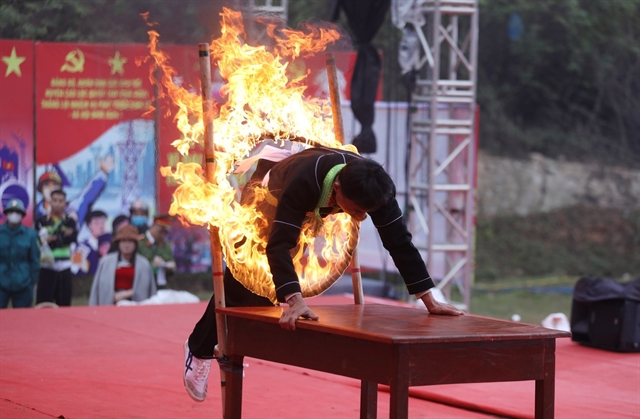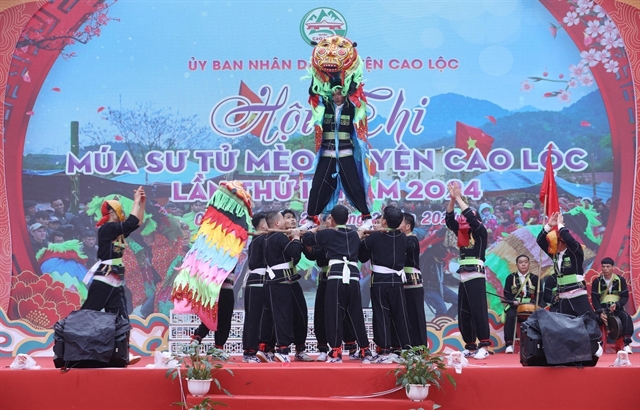 Features
Features

 |
| The cat-lion dance is a distinctive folk art of the Tày and Nùng ethnic communities in Lạng Sơn Province. VNA/VNS Photo Anh Tuấn |
The Tày and Nùng ethnics in the northern province of Lạng Sơn have preserved many unique cultural traditions, including the vibrant cat-lion dance.
According to Hoàng Văn Páo, chairman of the Heritage Association of Lạng Sơn, the cat-lion dance is a distinctive folk art form of the Tày and Nùng ethnic communities, who account for more than 80 per cent of the province’s population. The cat-lion represents luck, grandeur, and a warrior spirit, symbolising prosperity, happiness, and abundance.
During the Lunar New Year Festival, the Tày and Nùng people often invite cat-lion dance troupes into their homes. They believe the cat-lion's presence will ward off evil spirits, prevent diseases, and ensure a peaceful and prosperous life throughout the year.
This folk art combines music, visual arts, and dance, holding significant cultural, historical, and social value. It reflects the worldview, emotions, and aspirations of the Tày and Nùng people, infused with humanistic values that promote goodness. These qualities have been preserved and passed down through generations.
 |
| FIRE: A performance during the cat-lion dance. |
The performance features essential props and diverse musical instruments, including drums, gongs and cymbals, which together create a unique folk orchestra. Performed by a group of 8 to 16 members, the dance includes a lead dancer representing the cat-lion, and others wearing masks of orangutans and monkeys, wielding props such as tridents, short swords and knives.
The cat-lion head, about 50cm in diameter, is crafted from clay and painted in vibrant colours such as green, red, black, yellow, and white, with a fierce expression. Its large eyes, wide mouth, and three horns are complemented by fabric whiskers and a green yarn "mane" that enhances its movement during the dance.
The dance routines vary depending on the event and purpose, such as welcoming deities, honouring ancestors, or praying for good fortune, good weather and bountiful harvest. Some routines even include acrobatics, such as jumping through fire.
Preservation efforts
 |
| The dance is believed to ward off evil spirits, prevent diseases, and ensure a peaceful and prosperous year. VNA/VNS Photo Anh Tuấn |
The cat-lion dance was recognised as a national intangible cultural heritage in 2017, prompting preservation efforts from government bodies, organisations, and local communities.
Phan Văn Hòa, deputy director of the Lạng Sơn Department of Culture, Sports and Tourism, said the department had conducted research and documentation on the dance to maintain its cultural value.
“To preserve and promote this heritage, local authorities have created spaces for cat-lion dance performances at festivals, organised competitions, and linked ethnic heritage with tourism development,” Hòa said.
A project running from 2021 to 2030, jointly implemented by the Department of Culture, Sports and Tourism and the Lạng Sơn People’s Committee [provincial administration], focuses on preserving and promoting the dance.
Since the project’s launch, 30 training classes have been held with nearly 200 participants, around 40 per cent of whom are youth and children.
“These courses have played a vital role in expanding the cat-lion dance movement within the Tày and Nùng communities,” Hòa added.
Currently, Lạng Sơn has nearly 100 cat-lion dance troupes with about 1,000 members, a 20 per cent increase since 2020. Many are based in areas such as Hồng Phong Commune in Bình Gia District, Tồng Riềng Village in Hải Yến Commune of Cao Lộc District, and Yên Phúc Commune in Văn Quan District.
Lý Mạnh Hưng, deputy chairman of the Hải Yến Commune People’s Committee, said local villages and schools had established dance clubs and teams. All kindergartens, elementary schools, and middle schools in the area had incorporated cultural heritage education, particularly the cat-lion dance, into extracurricular activities. Schools had also set apart rooms to display photos and cat-lion masks.
“These efforts have increased awareness and inspired a love for the dance among young people, ensuring the tradition’s continuation. Master artisans and dance troupes are actively involved in passing on these cultural values,” Hưng said.
The local cat-lion dance troupe in Yên Phúc Commune, led by Linh Văn Chiến, has been actively training new performers. Established in 2018 with eight members, the troupe recently opened a training class, welcoming nine new members aged 11 to 12 years. VNS




